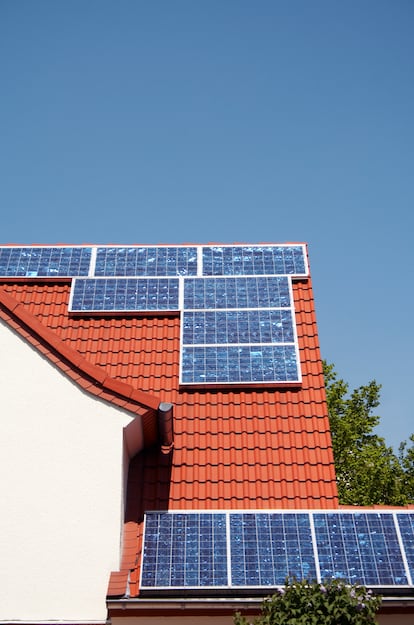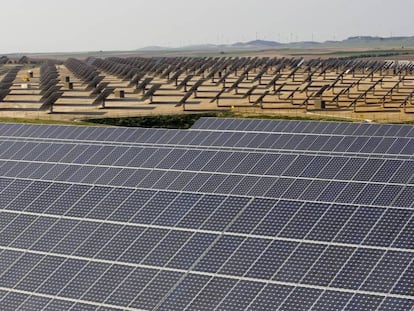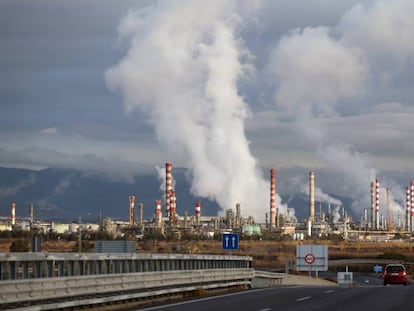How to avoid a botched solar panel installation in Spain
Industry leaders create a quality seal as demand rises on the back of lower prices and the promise of EU funds for more energy-efficient homes


The sun is shining brighter than ever in Spain, and for good reason: the Plan for the Recovery, Transformation and Resilience of the Spanish Economy includes significant subsidies for homes improving their energy efficiency, and it will not only be multi-owned apartment blocks that are eligible, but also stand-alone homes installing photovoltaic solar panels, according to the Transportation, Mobility and Urban Agenda Ministry. Moreover, the number of homeowners who have installed solar panels on the roofs of their homes has reached record figures in the last year, which in turn has boosted demand for solar panel installation technicians.
But while the solar boom is welcome, it has highlighted the poor quality of some installations and lack of training among technicians. “The most common error is failing to avoid partial shadows, due to an antenna, for example,” says Jorge Morales, director of power company Próxima Energía. “You can lose up to 50% of efficiency that way.” Other problems include panels that are not properly attached to roofs, meaning they fly off in high winds. And in other cases, the panels are causing leaks in the roof.
People whose jobs have not been affected by the pandemic have saved money to go through with the installation, which costs, on average, between €4,000 and €6,000José Donoso, general manager of UNEF
To avoid this kind of botched job and lack of maintenance that has been prevalent since 2006, the Spanish Photovoltaic Union (UNEF) has just created a quality seal for installation companies, establishing a certification system that guarantees that the installation of photovoltaic self-consumption panels is carried out in accordance with rules defined by a committee of industry experts.
There is concern about the lack of experience in “a sector that is generating a lot of employment with a lot of new companies being set up,” says José Donoso, general manager of UNEF. “We want solar technicians to have the proper training; to take exams to give them approved certificates.” The association says that this quality seal was created in response to the needs of the sector which is seeing soaring demand for photovoltaic self-consumption installations.
In Spain, 596 megawatts (MW) of new photovoltaic power were installed for self-consumption in 2020, 30% more than in 2019, according to UNEF data. After almost 40 years of hesitancy, residential self-consumption has taken a huge leap forward during the coronavirus pandemic. The surprise has been the growth within the housing sector, which already accounts for a 20% share and has gone from 40 MW to more than 100 MW in a year, according to Donoso – a trend that has continued in the first three months of 2021. “This has come as a big surprise,” he says. “It was not predicted and it is due to the fact that people whose jobs have not been affected by the pandemic have saved money to go through with the installation, which costs, on average, between €4,000 and €6,000. There are also an increasing number of cities applying tax deductions to the IBI [property tax].”
In Spain, 596 megawatts of new photovoltaic power were installed for self-consumption in 2020, 30% more than in 2019
The main clients for domestic self-consumption are people with homes with an installed capacity of 100 kilowatts (kW) or less that use a system of simplified compensation – the value of the surplus energy is deducted from their electricity bill at a price agreed with the supplier. Shared self-consumption in multi-owned apartment blocks is not yet a big player, though this sector is predicted to grow with European Union subsidies and the forthcoming reform of the Horizontal Property Law (which regulates the rights of ownership of an individual property within a residents association) to facilitate majority agreements.
Large retail companies, such as El Corte Inglés, Fnac, Leroy Merlin, Ikea and MediaMarkt, have jumped at the chance of dominating the photovoltaic solar panel market by signing agreements with electricity companies and retailers. Ikea, for example, partnered with Contigo Energía at the beginning of March to offer turnkey solutions for domestic solar energy.
The partnership offers two types of solar installation to suit all kinds of homes and budgets: one has up to 340 kW of peak power per panel and another has 390 kW per panel and optimizers that make the system 10% more efficient. Savings can amount to as much as 50% of the energy bill. “The investment ranges from €4,000 to €12,000,” explains Qi Kai Sheng, head of sustainability at Ikea Spain, who spoke during a conference organized by UNEF. “For a small house, three or four [panels] are enough, and for larger houses with an electric car, 12 panels are needed.” Most of the installations so far have between six and 10 panels.
Ikea expects to have cornered 7% of the market by 2024 and to be reaching thousands of households in the near future. “We have already seen a lot of consumer interest and considering that people are spending more time at home due to the pandemic, we could expect sales to exceed forecasts,” says Kai Sheng.
Return on investment
As panels last for 20 years, more and more homeowners see these installations as a profitable and long-term investment rather than an expense. But to calculate the potential return on each kind of installation a personalized analysis is required because there are many factors at play, such as the time of day of consumption, the orientation of the roof and the presence of shadows, according to Morales. “In some cases, it will be 4% and in others 20%,” he says.
Morales explains how the return on investment was calculated for a potential client in Roquetas de Mar in the Almería region of Andalusia. The return on the installation consisting of 14 panels is 13.1% and the initial layout is €7,990. The estimated saving on the electricity bill over 25 years is €27,425. In this case, self-sufficiency amounts to 43%.
Thriving at last without the so-called “sun tax” that was eliminated in 2018, the solar sector’s most significant obstacle for the promotion of self-consumption is the building permit required by some regions, which can take six to eight months to issue. Last week, UNEF managed to get Navarre to follow in the footsteps of 10 regions and ditch the requirement, but Madrid, Murcia, La Rioja, the Basque Country, Cantabria and Asturias are yet to do so.
There is however another equally significant obstacle: Spain is one of the countries with the highest fixed charge on the electricity bill – 40%, compared to the European average of 23%. And Morales indicates two further hitches: “the regulatory gaps and different procedures between regions and the excessive zeal of the distribution companies, which then take two months to activate the simplified compensation.”
English version by Heather Galloway.
Tu suscripción se está usando en otro dispositivo
¿Quieres añadir otro usuario a tu suscripción?
Si continúas leyendo en este dispositivo, no se podrá leer en el otro.
FlechaTu suscripción se está usando en otro dispositivo y solo puedes acceder a EL PAÍS desde un dispositivo a la vez.
Si quieres compartir tu cuenta, cambia tu suscripción a la modalidad Premium, así podrás añadir otro usuario. Cada uno accederá con su propia cuenta de email, lo que os permitirá personalizar vuestra experiencia en EL PAÍS.
¿Tienes una suscripción de empresa? Accede aquí para contratar más cuentas.
En el caso de no saber quién está usando tu cuenta, te recomendamos cambiar tu contraseña aquí.
Si decides continuar compartiendo tu cuenta, este mensaje se mostrará en tu dispositivo y en el de la otra persona que está usando tu cuenta de forma indefinida, afectando a tu experiencia de lectura. Puedes consultar aquí los términos y condiciones de la suscripción digital.
More information
Últimas noticias
From safe-haven investment to geostrategic weapon: Who owns the most gold and where are the bars kept?
Todd Green, head of the company that created ‘Candy Crush’: ‘Success for us is that players want to play for years’
Prices soar and Venezuela’s economy struggles under Trump’s pressure: ‘People are living day to day’
Magnets in their heads: How some animals guide themselves using the Earth’s magnetic field
Most viewed
- Why we lost the habit of sleeping in two segments and how that changed our sense of time
- Charles Dubouloz, mountaineering star, retires at 36 with a farewell tour inspired by Walter Bonatti
- Venezuela faces its most tense Christmas yet
- CBS in crisis after pulling a report on Trump’s deportations to El Salvador (which later leaked online)
- Bukele clan fumes over investigation exposing their new wealth










































